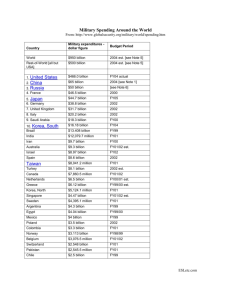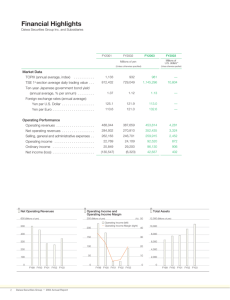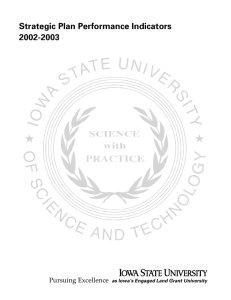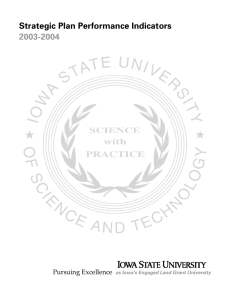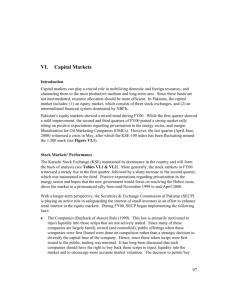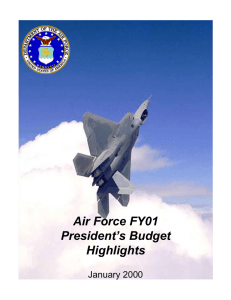Strategic Plan Progress Report 2001-2002 Pursuing Excellence
advertisement
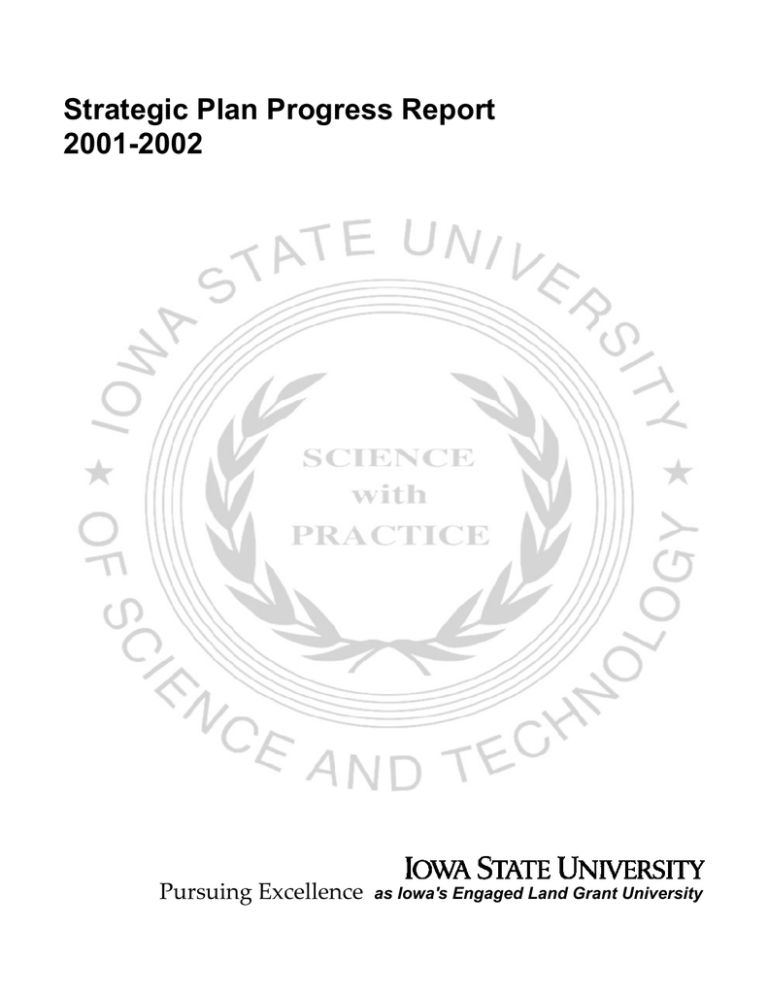
Strategic Plan Progress Report 2001-2002 Pursuing Excellence as Iowa's Engaged Land Grant University A Letter from President Gregory L. Geoffroy Despite a challenging year in terms of funding and budgets, Iowa State University continued to make important and necessary progress towards fulfilling the goals of its 2000Excellence as Iowa’s Engaged Land-Grant University.” 2005 Strategic Plan, “Pursuing The outlines of the funding challenges we faced and met are familiar. There was a reduction in the state appropriation in Spring 2001 followed by two de-appropriations during the 2001-2002 fiscal year, inal budget cut in formulating the FY03 budget, and a shortfall in funding of salary and compensation increases in spring 2002. All of this necessitated the elimination of many positions, a f including faculty. enjoyed a year of accomplishments and strong outcomes toward meeting the three priority goals of our strategic plan: learning, discovery, and engagement. We did not let the economic challenges dampen our commitment to achieving excellence and to meeting In spite of these challenges, the University the needs of the people of Iowa. We enjoyed an increase in student enrollments, and we continued the great success of our learning communities; the Center for Teaching Excellence, Academic Information Technologies, ISU Comm, and other initiatives all helped strengthen faculty teaching skills, the bonding of students to the institution, and the learning that takes place in our classrooms, laboratories, and in the field. One measure of -reporting our students make about finding employment and/or continuing on to professional and/or graduate education. Employers and others very clearly success is the self in their respective fields value an Iowa State University degree. We enjoyed similar success in our discovery goal. Sponsored funding increased over 50% t -time high in FY 2002. Iowa State continues to rank very high in the R&D 100 Awards competition, the number of patents earned, invention disclosures received, and in licenses executed and yielding income. The Plant Sciences Institute is becoming a major worldwide center for research in the plant sciences, and we began exciting initiatives in such fields as information assurance, he past five years and reached an all food safety, and biorenewable resources. We also continued our historic mission of engagem population interacted with Iowa State University and ISU Extension to receive education, to improve their quality of life, and to improve economic prospects for them, their companies, and their communitie ent, the land grant ideal. More than 20% of Iowa’s s. I am very excited about our accomplishments and the future as we continue to strengthen the academic excellence of Iowa State University and build upon the traditions that make us one of the nation’s best -grant miss universities in fulfilling its land Gregory L. Geoffroy President, Iowa State University ion. Performance Indicators 1 One-year undergraduate persistence rate. One-year Persistence 100% Entry year Native Am African Am Asian Am Hispanic White All Minority 2005 Goal 1997 54.5% 79.5% 89.9% 80.4% 83.9% 83.6% 82.4% 90.0% 1998 80.0% 82.7% 87.7% 81.1% 84.6% 84.4% 83.9% 90.0% 1999 75.0% 80.7% 89.5% 85.3% 85.2% 85.1% 83.9% 90.0% 2000 40.0% 85.6% 92.0% 82.5% 83.6% 83.7% 85.5% 90.0% 2001 83.3% 84.9% 82.9% 79.8% 83.7% 83.4% 82.9% 90.0% 80% 60% 40% 20% 0% 1997 1998 All 2 1999 2000 Minority 2001 2005 Goal Six-year undergraduate graduation rate. Six-year Graduation Rate Entry year Native Am African Am Asian Am Hispanic White All Minority 2005 Goal 1992 40.0% 27.3% 56.4% 36.5% 62.7% 61.1% 38.6% 70.0% 1993 28.6% 33.5% 53.4% 55.4% 62.7% 60.4% 40.7% 70.0% 1994 71.4% 34.0% 72.0% 50.9% 63.1% 62.4% 51.3% 70.0% 1995 50.0% 43.5% 64.1% 35.6% 64.7% 63.7% 49.2% 70.0% 1996 42.9% 40.0% 61.0% 45.0% 66.5% 65.3% 48.2% 70.0% 100% 80% 60% 40% 20% 0% 1992 1993 All 3 Percent of all undergraduate students who participated in a study abroad experience during the academic year. 1994 1995 Minority 1996 2005 Goal Participation in Study Abroad 10% Number Percent 2005 Goal AY98 602 2.9% 5% AY99 802 3.8% 5% AY00 898 4.2% 5% AY01 962 4.4% 5% AY02 797 3.5% 5% 8% 6% 4% 2% 0% AY98 AY99 Percent 2 AY00 AY01 AY02 2005 Goal 4 Number of undergraduate students enrolled in learning communities during the academic year. Number 2005 Goal 1998 1,114 2,500 1999 1,779 2,500 2000 1,838 2,500 2001 2,103 2,500 2002 2,139 2,500 Undergraduates Enrolled in Learning Communities 3,000 2,500 2,000 1,500 1,000 500 0 1998 1999 2000 2001 Number 5 Percent of student credit hours (SCH) earned by undergraduate students who participated in practicum/internships that earn academic credit. (excludes Veterinary Medicine) 2002 2005 Goal Participation in Practicums and Internships 4.0% 3.5% SCH Percent 2005 Goal FY98 11,880 2.0% 2.3% FY99 12,279 2.0% 2.3% FY00 12,245 2.0% 2.3% FY01 13,480 2.1% 2.3% FY02 13,252 2.0% 2.3% 3.0% 2.5% 2.0% 1.5% 1.0% 0.5% 0.0% FY98 FY99 FY00 Percent 6 Level of academic challenge. National Survey on Student Engagement First Year 2005 Goal 2000 46.9 54.0 2001 49.7 54.0 Seniors 2005 Goal 48.6 56.0 50.5 56.0 FY01 FY02 2005 Goal Level of Academic Challenge 100 80 60 40 20 0 2000 2001 First Year 2005 Goal 3 Seniors 2005 Goal Performance Indicators 7 Active collaborative learning. National Survey on Student Engagement Active Collaborative Learning 100 First Year 2005 Goal 2000 39.2 40.0 2001 35.8 40.0 Seniors 2005 Goal 51.2 48.0 45.5 48.0 80 60 40 20 0 2000 2001 First Year 2005 Goal 8 Enriching educational experience. National Survey on Student Engagement Seniors 2005 Goal Enriching Educational Experience 100 First Year 2005 Goal 2000 47.0 59.0 2001 53.8 59.0 Seniors 2005 Goal 43.9 49.0 43.6 49.0 80 60 40 20 0 2000 2001 First Year 2005 Goal 9 Number of FTE students per FTE tenured/tenure-eligible faculty member. Number 2005 Goal 1998 16.7 17.0 1999 17.2 17.0 2000 17.7 17.0 2001 18.7 17.0 2002 19.5 17.0 Seniors 2005 Goal Number of FTE Students per FTE Tenure/Tenure Eligible Faculty 24.0 20.0 16.0 12.0 8.0 4.0 0.0 1998 1999 2000 Number 4 2001 2002 2005 Goal 10 Percent of undergraduate student credit hours taught by tenured or tenure eligible faculty. Undergraduate Student Credit Hours Taught by Tenured Faculty 100% Percent 2005 Goal Fall 1997 62.1% 70.0% Fall 1998 63.2% 70.0% Fall 1999 61.2% 70.0% Fall 2000 58.1% 70.0% Fall 2001 60.1% 70.0% 80% 60% 40% 20% 0% Fall 1997 Fall 1998 Fall 1999 Fall 2000 Fall 2001 Percent 11 Percent of students who are part of an ethnic minority group. 2005 Goal Fall Enrollment - Percent Minority 10% Minority FTE Minority % 2005 Goal 1998 1,687 6.6% 8.5% 1999 1,730 6.6% 8.5% 2000 1,781 6.6% 8.5% 2001 1,943 7.0% 8.5% 2002 2,039 7.3% 8.5% 8% 6% 4% 2% 0% 1998 1999 2000 Minority % 12 Percent of tenured and tenure eligible faculty who are part of an ethnic minority group. 2001 2002 2005 Goal Percent Minority Faculty 25% Number Percent 2005 Goal 1997 162 11.4% 15.0% 1998 172 12.0% 15.0% 1999 181 12.7% 15.0% 2000 196 13.8% 15.0% 2001 205 14.7% 15.0% 20% 15% 10% 5% 0% 1997 1998 Percent 5 1999 2000 2001 2005 Goal Performance Indicators 13 Percent of staff members who are part of an ethnic minority group. Percent Minority Staff 14% Number Percent 2005 Goal 1997 172 8.1% 10.0% 1998 163 7.5% 10.0% 1999 178 7.9% 10.0% 2000 176 7.7% 10.0% 2001 184 7.9% 10.0% 12% 10% 8% 6% 4% 2% 0% 1997 1998 1999 Percent 14 2000 2001 2005 Goal Percent of tenured and tenure eligible faculty who are female. Percent Female Faculty 35% Number Percent 2005 Goal 1997 325 22.8% 30.0% 1998 338 23.5% 30.0% 1999 343 24.1% 30.0% 2000 361 25.3% 30.0% 2001 361 25.9% 30.0% 30% 25% 20% 15% 10% 5% 0% 1997 1998 Percent 15 Number of academic programs ranked in the top 25th percentile by national disciplinary surveys in 2001-2002 Number 2005 Goal 1999 2000 2005 Goal The Gourman Report: Graduate & Professional Programs Agriculture Engineering 9 (3 of 32) Agriculture Science 16 (5 of 32) Horticulture 11 (3 of 27) Nutrition 21 (8 of 38) Plant Pathology 10 (3 of 30) The Gourman Report: Undergraduate Programs Aerospace Engineering 24 (11 of 46) Agriculture 3 (3 of 120) Agriculture and Biosystems Engineering 7 (3 of 45) Agriculture Business 5 (6 of 110) Agronomy 2 (3 of 121) Animal Science 6 (4 of 64) Bacteriology and Microbiology 15 (33 of 219) Biochemistry 9 (29 of 312) Biology 7 (47 of 630) Biophysics 20 (12 of 60) Botany 10 (18 of 173) Chemistry 3 (19 of 555) 2002 48 55 National Research Council Chemistry 15.5 (26 of 168) Statistics and Biostatistics 21.5 (14 of 65) US News and World Report Learning Communities 21 (5 of top 25) Other Rankings Agriculture Education and Studies 5 (top 5 of 90) Animal Science 20 (2 of 10) Architecture 6 (7 of 112) Interior Design 7 (10 of 113) Rural Sociology 9 (top 5 of 56) 6 2001 The Gourman Report: Undergraduate Programs (cont.) Child Psychology 5 (9 of 164) Civil Engineering 19 (27 of 144) Computer Science 15 (38 of 260) Dairy Science 12 (5 of 43) Dietetics 5 (6 of 127) Earth Science 12 (6 of 49) Economics 6 (38 of 627) Entomology 20 (11 of 55) Fish & Game Management 22 (11 of 51) Food Science 3 (3 of 100) Food Service Management 7 (5 of 72) 16 Home Economics 3 (6 of 177) Horticulture 4 (3 of 77) Hotel, Restaurant & Institutional Management 7 (9 of 132) Industrial Engineering 15 (13 of 86) Landscape Architecture 23 (9 of 39) Mechanical Engineering 13 (25 of 200) Meteorology 7 (3 of 41) Nutrition 1 (2 of 218) Ornamental Horticulture 8 (2 of 24) Statistics 9 (6 of 70) Urban Planning 15 (6 of 41) Zoology 9 (12 of 129) Number of current faculty members in national academies and emeritus faculty members who are still active in the university. (National Academy of Sciences, National Academy of Engineering, Institute of Medicine, American Academy of Arts and Sciences) FY02 6 10 Number 2005 Goal National Academy of Sciences John Corbett, Chemistry Donald Duvick, Agronomy Arnel Hallauer, Agronomy Harley Moon, Veterinary Pathology National Academy of Engineering Donald Thompson, Aerospace Engineering Institute of Medicine Catherine Woteki, Agriculture Administration 17 Number of faculty members who are fellows of national and international scientific/disciplinary associations. Number in parentheses is the number of national or international societies. Number 2005 Goal 18 FY02 185 (254) 200 Number of faculty who are journal editors or on editorial or advisory boards of national/international professional journals. Number in parentheses is the number of professional journals and editorial/advisory boards FY02 (60) a. Journal Editors 2005 Goal 50 55 b. On Editorial / Advisory Boards 2005 Goal 284 (478) 300 7 Performance Indictors 19 Percent of tenured/tenure-eligible faculty with at least one scholarly work published, exhibited, or performed in the last three years. Percent Faculty Published During the Last Three Years 100% (based on calendar year) 80% Percent 2005 Goal 97-98 87.0% 90.0% 98-99 86.8% 90.0% 99-00 88.4% 90.0% 00-01* 83.2% 90.0% 01-02 83.7% 90.0% 60% 40% 20% *Beginning 2000-01 new methodology was used to calculate this figure 0% 97-98 98-99 99-00 Percent 20 Percent of tenured/tenure-eligible faculty who are principal or co-principal investigators for projects receiving external sponsored funding 00-01* 01-02 2005 Goal Percent Faculty as P.I... or Co-P.I.. 100% 80% Percent 2005 Goal FY98 59% 67% FY99 59% 67% FY00 57% 67% FY01 57% 67% FY02 57% 67% 60% 40% 20% 0% FY98 FY99 FY00 Percent 21 FY01 FY02 2005 Goal Total annual external sponsored funding. Sponsored Funding Per Year $300 Millions 2005 Goal FY98 $156.2 $250.0 FY99 $199.2 $250.0 FY00 $211.2 $250.0 FY01 $217.7 $250.0 FY02 $225.4 $250.0 $250 $200 $150 $100 $50 $0 FY98 FY99 Millions 8 FY00 FY01 FY02 2005 Goal 22 External sponsored funding per FTE faculty. Dollars 2005 Goal FY98 $111,100 $200,000 FY99 $143,000 $200,000 FY00 $153,500 $200,000 Sponsored Funding Per FTE Faculty FY01 $158,097 $200,000 FY02 $166,767 $200,000 $240,000 $200,000 $160,000 $120,000 $80,000 $40,000 $0 FY98 FY99 FY00 FY01 Dollars 23 New patent applications filed. # Patent Apps 2005 Goal 52 40 FY99 55 40 FY00 59 40 FY01 33 40 FY02 30 40 2005 Goal Number of New Patent Applications Filed 80 FY98 FY02 70 60 50 40 30 20 10 0 FY98 FY99 FY00 # Patent Apps 24 Number of new technologies licensed/optioned annually. 80 # Licensed 2005 Goal FY98 70 50 FY99 55 50 FY00 35 50 FY01 33 50 FY02 37 50 FY01 FY02 2005 Goal Number of New Technologies Licensed 70 60 50 40 30 20 10 0 FY98 FY99 FY00 # Licensed 9 FY01 FY02 2005 Goal Performance Indicators 25 Number of licenses and options executed. Number of Licenses/Options Executed 350 # Licenses 2005 Goal FY98 198 250 FY99 332 250 FY00 230 250 FY01 216 250 FY02 297 250 300 250 200 150 100 50 0 FY98 FY99 FY00 # Licenses 26 Number of extension clients served FY01 FY02 2005 Goal Number of Extension Clients Served 1,000,000 Clients served 2005 Goal FY98 468,043 800,000 FY99 499,537 800,000 FY00 727,370 800,000 FY01 657,316 800,000 FY02 665,354 800,000 800,000 600,000 400,000 200,000 0 FY98 FY99 FY00 FY01 Clients served 27 FY02 2005 Goal Distance and continuing education: credit course registrations. Fall Enrollment - Credit Registrations 7,000 Credit 2005 Goal FY98 2,652 5,950 FY99 3,333 5,950 FY00 4,734 5,950 FY01 5,050 5,950 FY02* 5,298 5,950 6,000 5,000 4,000 *this does not include an additional 9,369 enrollments in evening and weekend courses 3,000 2,000 1,000 0 FY98 FY99 Credit 10 FY00 FY01 FY02* 2005 Goal 28 Distance and continuing education: non credit course registrations. Non-credit 2005 Goal FY98 286,482 512,000 FY99 289,729 512,000 FY00 420,380 512,000 FY01 442,121 512,000 FY02 419,378 512,000 Fall Enrollment - Non-Credit Registrations 600,000 500,000 400,000 300,000 200,000 100,000 0 FY98 FY99 FY00 FY01 Non-credit 29 Dollars raised on behalf of Iowa State University by the Iowa State University Foundation FY02 2005 Goal Gift Income $120 In millions Gift Income 2005 Goal FY98 $89.0 $100.0 FY99 $108.6 $100.0 FY00 $112.5 $100.0 FY01 $70.1 $100.0 FY02 $66.0 $100.0 $100 $80 $60 $40 $20 $0 FY98 FY99 FY00 FY01 Gift Income 30 Percentage of living alumni who made gifts to the Iowa State University Foundation to support Iowa State University FY02 2005 Goal Alumni Giving Rate 30% Percent 2005 Goal FY01 11.7% 20% FY02 13.7% 20% 25% 20% 15% 10% 5% 0% FY01 Percent 11 FY02 2005 Goal Performance Indicators 31 Average faculty salary by rank (based on 9-month) Index of Faculty Salaries Compared to Peer Land Grant - All Ranks Professor Assoc. Prof. Assist. Prof. 97-98 $77,021 $56,981 $46,416 98-99 $79,406 $59,425 $47,877 99-00 $83,180 $62,131 $50,744 00-01 $85,702 $63,442 $53,293 01-02 $88,196 $65,771 $54,973 1.10 1.05 1.00 Index of Average ISU Faculty Salaries Compared to Peer Land Grant Universities Professor Assoc. Prof. Assist. Prof. All Ranks 2005 Goal FY98 1.00 1.01 0.97 1.00 1.00 FY99 0.99 1.00 0.97 0.99 1.00 FY00 0.98 1.00 0.99 0.99 1.00 FY01 0.97 0.98 0.98 0.98 1.00 0.95 FY02 0.96 0.98 0.97 0.97 1.00 12 0.90 FY98 FY99 All Ranks FY00 FY01 FY02 2005 Goal Iowa State University does not discriminate on the basis of race, color, age, religion, national origin, sexual orientation, sex, marital status, disability, or status as a U.S. Vietnam Era Veteran. Any persons having inquiries concerning this may con tact the Director of Equal Opportunity and Diversity, 1350 Beardshear Hall, 515-294-7612 Produced and designed by the Office of Institutional Research and Mark Chidister Printed by ISU Printing Services 11.02
